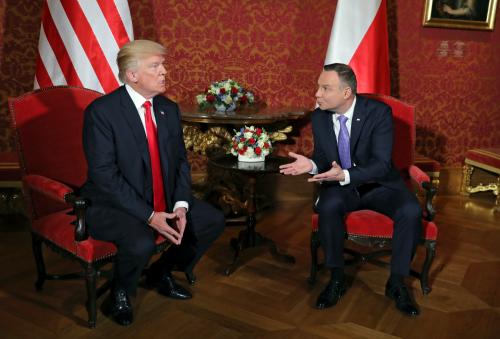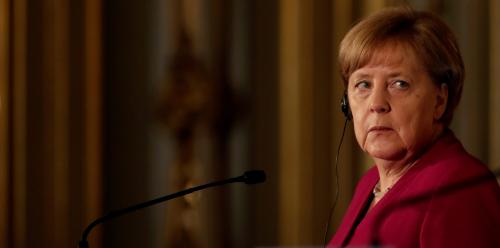History has repeatedly shown that the United States and Europe are stronger and more effective when working together, write Julie Smith and Amanda Sloat. This piece originally appeared in Foreign Policy.
Talk to any long-standing observer of the trans-Atlantic relationship and you will hear that the United States and Europe are on a collision course. From climate change to the Iran nuclear deal to tariffs on steel and aluminum, the two sides of the Atlantic increasingly find themselves at odds over a long list of foreign-policy and trade issues. But those same observers will also tell you that trans-Atlantic rifts have been a long-standing feature of the relationship, surfacing quite regularly over the last 70 years. The real question is whether what the trans-Atlantic partners are experiencing today is any different from, say, the deep divisions they experienced over the Iraq War. It didn’t take that long for Europe and the United States to overcome that disagreement and return to a rich agenda of cooperation. In other words, the United States snapped back then and will snap back again (presumably once President Donald Trump has left office). Right? Not so fast.
The United States and Europe have had ruptures over trade before and managed to more or less resolve them respectfully, without questioning the institutions or values that have served as the bedrock of the relationship.
But in 2018, the United States has a leader who wants to be provocative, disruptive, and unpredictable just for the sake of it. Trump is challenging conventional foreign-policy wisdom on numerous issues: withdrawing the United States from the Iran nuclear agreement and Paris climate accord, moving the U.S. Embassy in Israel to Jerusalem, and imposing tariffs on steel and aluminum imports. He is openly fighting with U.S. allies (especially Germany) and world leaders, engaging in an unprecedented Twitter dispute before an international summit. While couching trade disputes with Washington’s closest allies in national security terms, he is calling for Russia’s return to the G-7 and lavishing praise on North Korea’s leader. He is also questioning long-held norms, such as the U.S. commitment to NATO security, the value of the European Union, and the merits of international trade.
Europeans have tried an array of strategies to engage him, from German Chancellor Angela Merkel’s stern headmaster approach to French President Emmanuel Macron’s charm offensive. But what has become clear in recent months is that Trump can’t be cajoled, charmed, or bullied. To his credit, he is focused on substance over style. He is sticking to his principles, primarily the deeply held belief that Europe has long been ripping off the United States.
More problematic is Trump’s apparent unwillingness to respond to logic or reason. Europeans are following the same learning curve that Americans went through last year: desperately looking for process, signs of normality, and a sense that things will eventually function as normal. But this is not normal. Europeans are beginning to realize the need to reposition themselves and engage differently with the United States. But how?
Committed Atlanticists on both shores are struggling to answer this question. Many of us have argued that Trump does not represent the views of all Americans, pointing to a plurality of perspectives. Throughout 2017, there was consensus that working more closely with Congress was time well spent. It appeared interested in holding the administration accountable and using its limited powers on foreign policy. But Congress has taken little interest in monitoring the administration’s execution of sanctions under the Countering America’s Adversaries Through Sanctions Act, the Senate hasn’t held a hearing on Russia in more than a year, and few Republican legislators, other than Sen. John McCain, are willing to challenge the president on his constant attacks on America’s closest allies.
As Trump increasingly treats U.S. allies as strategic competitors bordering on adversaries, some Europeans are seemingly considering whether to view the United States as an adversary in response. In the run-up to the G-7 summit in Quebec, Canada, which began Friday, Macron tweeted:
The American President may not mind being isolated, but neither do we mind signing a 6 country agreement if need be. Because these 6 countries represent values, they represent an economic market which has the weight of history behind it and which is now a true international force https://t.co/UA86fcjozs
— Emmanuel Macron (@EmmanuelMacron) June 7, 2018
If this was the mood music before the G-7, imagine how bad things will be at next month’s NATO Summit.
History has repeatedly shown that the United States and Europe are stronger and more effective when working together.
Yet these lessons seem to be forgotten, as we are rapidly approaching a dangerous moment in the trans-Atlantic relationship. This week began with commemorations marking the 74th anniversary of D-Day, a decisive battle that helped end a devastating world war, led to active U.S. involvement in rebuilding a strong and prosperous Europe, and heralded decades of successful trans-Atlantic cooperation on shared problems. This week is ending with the potential exclusion of the United States from a joint statement of the world’s leading industrialized nations. The deterioration of this relationship will be devastating to the United States, Europe, and their collective global interests. The American people, and Congress, need to speak out before it is too late.







Commentary
The United States and Europe still need each other
June 11, 2018